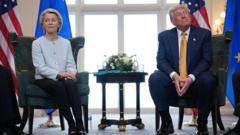The trade deal between the European Union and the United States, recently announced amidst much fanfare, is drawing criticism from various European quarters, highlighting concerns over its incomplete nature and potential economic impacts. When European Commission head Ursula von der Leyen and U.S. President Donald Trump unveiled the agreement after weeks of high-stakes negotiations, many Europeans let out a sigh of relief, dodging the 30% tariffs previously threatened by the U.S. administration. However, the situation quickly shifted as numerous EU leaders began to voice their dissatisfaction with the deal's specifics.
The newly introduced 15% tariff on a broad range of EU goods to the U.S., while improved from earlier proposals, marks a stark increase from the previously low average tariff of 4.8%. German Finance Minister Lars Klingbeil articulated a sentiment shared among many, noting a desire for a firmer EU stance but also acknowledging the importance of securing an agreement to avert further escalations.
Despite the apparent positives, significant discrepancies remain between the two sides regarding the deal's details. A joint statement expected to clarify terms has not been publicly released as of yet. The European Union insists that the agreement will merely serve as a set of political commitments rather than a binding contract, which contrasts sharply with U.S. assertions of achieving "historic structural reforms."
Continued discussions between EU and U.S. officials indicate that the negotiations are far from over. French President Emmanuel Macron characterized the deal as an initial step in what will likely be a prolonged negotiation process. Trade experts anticipate that trade agreements typically surfacing over 18 to 24 months will gradually solidify details, including potential exemptions from the tariffs.
Within the negotiations, critical divergences persist. For example, the EU stipulates that specific sectors, including pharmaceuticals and semiconductors, will maintain their current 0% tariff rates, a position seemingly at odds with the U.S. announcement that suggests a general implementation of the 15% rate. Furthermore, issues surrounding proposed U.S. military equipment purchases and commitments from EU nations raise questions about feasibility and intent, leaving ambiguity over whether U.S. targets can realistically be met.
While some nations may see progress, the fallout from the trade deal could prove uneven, with countries like Germany, Ireland, and Italy particularly vulnerable to the new tariffs. German automotive exports stand to lose billions under the new framework, with much of their market heavily reliant on U.S. purchases. Ireland's significant engagement in pharmaceutical exports to the U.S. similarly leaves them feeling cornered, caught between economic necessities and unfavorable terms.
As the EU grapples with the implications of these tariffs, national leaders are already calling for potential compensations to mitigate losses. Yet, some analysts warn against such measures, arguing that blanket compensation would serve as a political win for the Trump administration, effectively shifting the financial burden onto EU taxpayers.
With continued dissent over the U.S.-EU trade agreement and the pressing need for clarity, European negotiators may find themselves with a challenging road ahead as they work to advocate for their nations' concerns while striving for a mutually beneficial resolution.





















